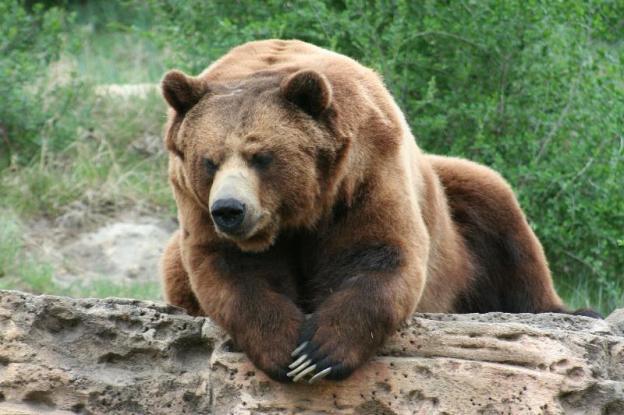Pinus lambertiana Dougl. – Sugar Pine
The sugar pine is a titan amongst its august congeners. It is the tallest (70′-200′) and heaviest pine species in the world. It also has the longest pine cones in the world, reaching over two feet long.
It’s range is thick in California and Oregon in the Sierras (reaching Carson City, NV), Northern California mountains, and the Cascades. It’s also found in the coast range of Big Sur, the mountains of Southern California, and into Baja California. Its preferred habitat is slopes in yellow pine forest and red fir forest (Calflora.org). It occurs from 390-9710 ft (Calflora.org), but is more common at higher elevations, about 2500-9000 ft. (Goodrich et al. 1980).
Throughout its range, Indian tribes found the sugar pine tree very useful, even for a pine tree, which are generally species with many edible parts and uses.
The most important resource this species provided were its seeds / pine nuts. These were gathered in the summer (Goodrich et al. 1980). When gathered in sufficient quantity, the large seeds from the long cones are as highly esteemed as those from the Digger pine, Pinus sabiniana (Chesnut 1902, Dixon 1905, Dixon 1907). Sugar pine nuts were known to be eaten by Mendocino area Indians, Northern Maidu, Shasta, and Kashaya Pomo (Chesnut 1902, Dixon 1905, Dixon 1907, Goodrich et al. 1980). The nuts were eaten fresh or dried for winter (Goodrich et al. 1980). Stored nuts were eaten whole or pounded into a flour and mixed with pinole, a blend of dried and powdered grains and small seeds (Goodrich et al. 1980).
To remove cones from a high tree limb, the Kashaya Pomo used a deer antler lashed to the end of a straight pole (Goodrich et al. 1980). As with other pine species, trees were probably also climbed to cut down branches with cones and shake down cones, in addition to simply picking off the ground.
The pine nuts were steamed in an earth oven by the Shasta (Dixon 1907). A hole was dug, a fire was burned inside it to heat a layer of rocks at the bottom, then the coals and ashes were raked out (Dixon 1907). Then the pine nuts, wrapped in leaves, were placed on the hot rocks (Dixon 1907). Then water was poured in, more hot rocks placed on top, and the whole covered with earth, allowing the oven to steam for several hours (Dixon 1907). The nuts were then dried and stored (Dixon 1907). When wanted to eat, the nuts were pounded fine, winnowed, and made into small cakes (Dixon 1907). Often powdered pine nuts were mixed with powdered salmon (Dixon 1907).
The sap of sugar pine tastes sweet; that is what gave the tree its common name. The sap was eaten and chewed as gum or candy by the Northern Maidu (Dixon 1905), Shasta (Dixon 1907), Kashaya Pomo (Goodrich et al. 1980), and Wintu (Jacknis 2004). It was gathered from spring through fall (Goodrich et al. 1980).
One form of this sap was valued as a medicine. The sugary exudation on partially burned bases of trees was valued for cathartic properties (Chesnut 1902). The sap was also used in making whistles (Goodrich et al. 1980), forming the crucial seal for generating sound. Just as other pine trees, its sap had many different uses as a sealant or mastic, such as hafting obsidian blades to wood handles or arrowheads to a shaft.
Although such a use for this particular species goes unmentioned in ethnographies I have studied so far, the inner bark of all pine trees is edible, and furnishes a easily-gathered, calorie-rich food.
Sugar pine logs were used by the Shasta for making dugout, square-ended canoes (Dixon 1907).
Like many other pine species, the sugar pine boughs and needles were commonly used to cover the floors of dwellings and pad beds (Barrett and Gifford 1951). However, Sugar pine boughs were specifically excluded from use as thatching, despite boughs of other pine tree species being commonly used for thatching (Barrett and Gifford 1951). I can only conjecture a higher ratio of sugar to terpene content compared to other pines makes the sugar pine needles more susceptible to decay, making it inferior thatching material.
This tree was also sometimes host to the Pandora moth (Carolin and Knopf 1968). The Pandora moth caterpillar was a crucial, abundant food of the Paiute and other Sierra Indians.
REFERENCES
Barrett, S.A. and E.W. Gifford. 1951. Miwok houses. In The California Indians: a source book. Edited by R.F. Heizer and M.A. Whipple.
Carolin, V.M. Jr. and J.A.E. Knopf. 1968. The pandora moth. USDA Forest Service Forest Pest Leaflet 114: 1-7.
Chesnut, V. K. 1902. Plants used by the Indians of Mendocino County, California. Government Printing Office, Washington, DC.
Dixon, Roland. B. 1907. The Shasta. American Museum of Natural History Bulletin 17(5).
Goodrich, J., Lawson, C., and Lawson, V. P. 1980. Kashaya Pomo plants. American Indian Studies Center, University of California, Los Angeles, CA.
Jacknis, Ira J (ed.). 2004. Food in California Indian culture. Phoebe Hearst Museum of Anthropology, University of California, Berkeley.
37.871593
-122.272747





